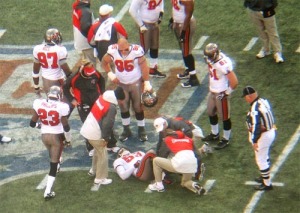
A significant increase
in body mass index (BMI)
for offensive and defensive
linemen has been noted
during the past 30 years
The cardiovascular health of professional football players and those players who aspire to professional status has become the focus of at least one study, which is being published in JAMA on May 27.
A significant increase in body mass index (BMI) for offensive and defensive linemen has been noted during the past 30 years, and body mass index fitting the category of class II obesity, reported in more than a quarter of National Football League (NFL) players in 2003, is another cause for alarm, researchers say.
Just as important, sporadic deaths of active and young retired professional football players have led researchers to investigate whether there's an increase in cardiovascular disease risk among retired NFL players.



Ad Statistics
Times Displayed: 316
Times Visited: 2 Keep biomedical devices ready to go, so care teams can be ready to care for patients. GE HealthCare’s ReadySee™ helps overcome frustrations due to lack of network and device visibility, manual troubleshooting, and downtime.
Studying this elite population, Andrew M. Tucker, M.D., of Union Memorial Hospital, Baltimore, and colleagues compared the prevalence of CVD risk factors in NFL players with average young men of the same age.
The study included 504 active men who are retired NFL players from 12 NFL teams.
Investigators did the usual workup: Data collected during team mini-camps between April and July 2007 included health histories; height; weight; neck, waist, and hip circumferences; as well as BMI, fasting glucose levels, total cholesterol, low-density lipoprotein cholesterol (LDL-C), high-density lipoprotein cholesterol (HDL-C), and triglycerides; blood pressure; pulse; and electrocardiograms.
Data were compared with men the same age, who were participants of the Coronary Artery Risk Development in Young Adults (CARDIA) study, a group which included 1,959 participants age 23 to 35 years old.
The NFL players were taller and heavier than the CARDIA group. The researchers found that despite their larger size, the NFL group had lower average fasting glucose levels and a significantly lower prevalence of impaired fasting glucose (6.7 percent vs. 15.5 percent) compared with the CARDIA group, perhaps because the athletes continued to exercise strenuously.
However, when push came to shove, there were no significant differences between the athletic and non-athletic males; the prevalence of high total cholesterol, high LDL-C, low HDL-C and high triglyceride levels were the same. It should be noted that the NFL players were less likely to smoke than the non-elite athletes in the CARDIA group (0.1 percent of former NFL players smoked versus 30.5 percent in the CARDIA group).
High Blood Pressure Worries
The statistic that worries researchers is the much higher blood pressure levels present among former NFL players. About 14 percent of retired NFL players had high blood pressure readings compared with 5.5 percent of non-athletes.

